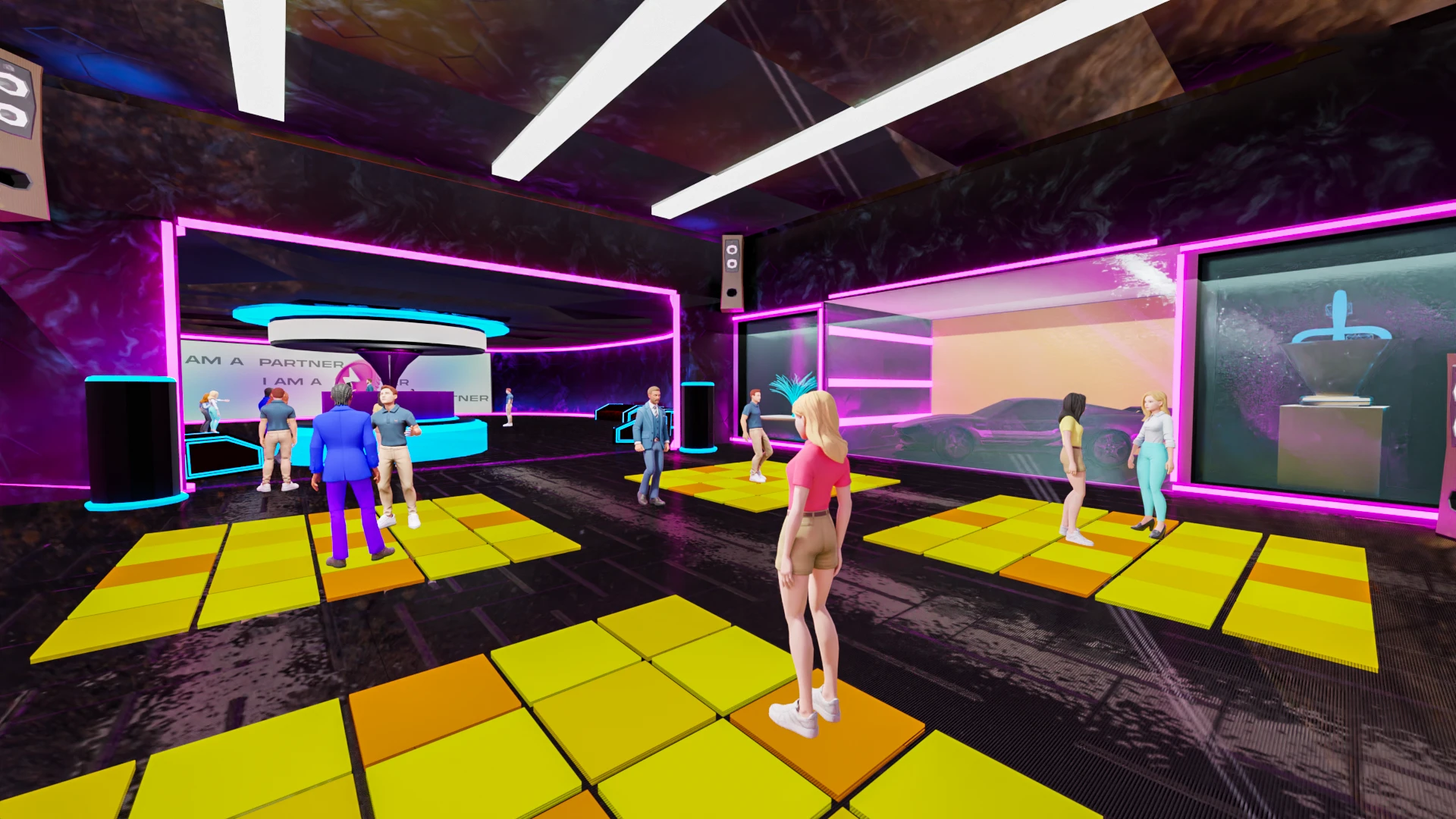Some say that the Metaverse is really the next iteration of the internet - which means it provides the perfect setting to launch something that is truly unique and innovative. Brands are increasingly turning to the Metaverse to introduce their products to a new generation of consumers that embrace and value virtual reality.
In 2022, Valdé Beauty hosted a product launch party in Decentraland, celebrating the introduction of three limited-edition luxurious lipstick cases. The launch party featured a live DJ and interactive product displays. It also boasted attendance by leading industry influencers. The lipstick cases were on full display in the site’s NFT gallery, along with a few tokens created in collaboration with Serena Elis and Adriana Krawcewitz.
According to the brand’s PR decision, the company decided to host the event in a virtual space in order to attract a crowd that felt passionately about art and NFTs and to support women from around the world at the same time and in the same place. The unique art gallery chosen in Decentraland enables female artists to display their work without buying space, which resonated with the beauty brand’s audience. Members could access VIP community experiences, interact and attend talks with the brand’s founder as well as celebrity makeup artists. Digital wearables were handed out to special guests. The fact that this was the first launch event hosted by a beauty company in the virtual world provided extra PR clout and attention for Valdé Beauty.
The Metaverse makes it far easier for companies to launch events. It’s far less expensive than renting a real-world venue, which requires catering, styling, furniture rental, security, and staff. It’s an ideal solution for trendy indie brands with big ideas and small budgets.
But how exactly do you approach a launch party in the Metaverse, what do you need, and more importantly, why should you host a launch in the Metaverse in the first place?
The Benefits of Hosting a Product Launch In the Metaverse
Since the pandemic, many companies have realized the benefits of hosting virtual events because of the lower cost, lower carbon footprint, and flexibility the medium offers. However, virtual events have always been lacking when it comes to engagement and have ended up as little more than passive environments resembling conference calls. The Metaverse has changed all that.
Instead of dull, one-way conferences with endless presentations, you can create gamified experiences in a rich and immersive environment that comes as close to a real-world event as possible online.

Some of the benefits of using the Metaverse for your product launch include the following:
- The ability to create a real-world experience online: On 2D apps, attendees have to be passive participants that watch presentations without any interaction. In the Metaverse, attendees can use their avatars to explore your product and feel as though they are really walking among other people and enjoying the event.
- The ability to gain insight from data: The Metaverse gives event organizers an opportunity to assess attendee behavior in a more meaningful way. A virtual booth can show you exactly who attended the launch, which content they downloaded or interacted with, which questions they asked, and what actions they took.
- The ability to scale: When you are launching a new product, having a large event at a low cost is the perfect scenario. The Metaverse doesn’t come with capacity limits, and no event is too far for attendees to visit. There are no travel costs or food expenses to consider, which means it’s far more affordable for participants to attend.
- The ability to innovate: Most of us are familiar with Zoom fatigue by now, and even real-world events have lost their shine now that we’re used to the convenience of interacting online. The Metaverse is growing and still quite novel, which means that you have the opportunity to be one of the first companies to host a product launch in a metaverse setting. This positions your company as a true innovator and gives your attendees a truly new experience.
- The ability to create a professional event in record time: Hosting an in-person event can take months to play. You have to ensure that there is adequate space, parking, catering, audio-visual equipment, guest speakers, accommodation and flights for guest speakers, security, and promotion. It can become an expensive and time-consuming experience. However, with metaverse events, you can easily create a fully branded, functional, easy-to-use web-based experience from scratch in a very short amount of time so that you can generate interest and gain traction for your product in record time.
The benefits are clear, but in order to make the most of the Metaverse, you still need to put some effort into planning your product launch, including refining your targeting, choosing the right platform, and overcoming the various pitfalls you may run into along the way.
Targeting the Right Guests
In most virtual worlds, like Decentraland, all events are public and anyone with an avatar can attend. This means that you are dealing with a global audience that is far more diverse.
The audience generally skews quite young - more than half of the metaverse population is aged thirteen and under. 83.5% of the 400 million people who regularly reside in the Metaverse are under the age of 18.
However, that leaves 52 million people who likely own cryptocurrency wallets and can attend your event (and buy your product). It’s a good idea to promote the event using your regular online, offline, and virtual channels to attract the audience you want.
Make sure that you highlight the benefits of the event. Metaverse events are far more immersive than traditional experiences and allow guests to get up close and personal with celebrities, influencers, and spokespeople in a way they wouldn’t be allowed to in the “real world.”
Choosing The Right Platform
If you’ve ever hosted a party in the real world, you know that not every venue you look at will be suitable for your needs. It’s important to evaluate virtual event venues with the same rigor as you would any real-world event space. Here are a few of the options to consider:

Horizon Worlds
Meta’s own Metaverse is known as Horizon or Horizon World. Its primary focus is organizing business meetings. Each team member receives a unique 3D avatar that enters a virtual meeting room, but you can scale the venue up and down and make changes to the layout depending on your requirements.
Horizon Worlds is a perfect platform for more formal B2B product launches, like financial or banking products, tech products, or other services. However, the technology is very new, and you and your guests will need the latest hardware and software to participate. It’s best not to use this for your product launch unless your customer base is already using Horizon and have the requisite Oculus Quest 2 gear needed to participate. You’ll also need basic gaming skills to navigate the space; if your guests aren’t particularly familiar with online games, they might not enjoy or find the launch experience accessible.
Party.Space
Party. Space is a customizable, browser-based metaverse that enables the simultaneous use of breakout chat rooms during large events. It’s a popular choice for enterprise companies, gaming businesses, and several fandoms. The platform is geared towards several events, from team-building activities to fundraisers. You don’t need additional devices or special technology to access and use Party. Space, which makes it far more accessible for the average user. It’s easy to share screens, show presentations and customize your environment. You can use spatial audio and your front-facing camera to show your face during an event. Having said that, you will need a strong internet connection to have the best possible experience.
Microsoft Mesh
Microsoft has invested heavily in the Metaverse and has ambitious plans for the future. Mesh has been designed for holographic collaboration. It can be accessed from any device through mixed-reality applications and allows for in-depth, immersive experiences. Mesh enables attendees to project themselves into a rich virtual world in photo-realistic form. Users can engage with eye contact, gestures, and even facial expressions and reactions. There’s no need for a VR headset; a mobile device will do (although HoloLens2 and other headsets are recommended to make the most of your experience). The interface is extremely intuitive, and it doesn’t require much practice before you get the hang of it. Mesh requires the use of Microsoft Teams, which does exclude participants that don’t already have it installed.
Decentraland
Decentraland is a virtual world built on the Ethereum blockchain. While the core functionality is to buy plots of land (NFTs) and cryptocurrency, many of the venues “built” in Decentraland are used for product launches and events. In 2022, Decentraland hosted a virtual Fashion Week across four days, with virtual runway shows, parties, celebrity DJs, and virtual outfits for sale. JP Morgan has created its official Onyx Lounge in the Metajuku mall, and there are several event venues, lounges, restaurants, and art galleries to choose from. Decentraland is extremely engaging, and most activities require a crypto wallet, which excludes the under-18 crowd. On the downside, peer-to-peer communications are a little limited, which means it’s not great for networking. However, if your goal is to sell or showcase products, you can really unleash your creativity and capture an interested audience.
Creating an Event For the Metaverse
Simply replicating an offline event in the Metaverse will just lead to a flat and dull experience for your guests. You have to take full advantage of all of the tools and tricks of the Metaverse if you want to succeed.

Make Sure It’s Fully Immersive
You can’t use the Metaverse the same way you would use Zoom or a video conferencing tool. Pictures and videos aren’t enough to keep your audience engaged - and it’s far easier to log off than it is to walk out of a real-world event. Remember that the Metaverse gives you an opportunity to engage potential buyers that walk past your displays into different rooms. Use the space! Create an expo hall, rooms for Q&As with important celebrities or influencers, and beautiful displays. You can outsource the design to a number of metaverse event firms if you don’t feel up to it on your own.
Generate Buzz
We’ve already mentioned using different channels to promote your event, including your social media channels. Tease small preview links, including sign-up and registration information, and follow up with formal e-vites with the correct information. Make sure that guests know exactly what they will need to participate in the event, whether it’s a crypto wallet, an avatar, an account, or a software upgrade/VR headset. Remember, many fans will sign up for the event and forget about it, so send reminders the day before the launch.
Don’t Forget About Making It Real
Don’t get so caught up in the virtual part of the experience that you forget about making the product real to your customers. Hosting a product launch in the virtual world means that your tangible product becomes intangible, so try to use the space to showcase your product and its applications as best as you can. Set up testing booths for new software, create simulations, and use videos. You can even create 3D walkthroughs or NFTs to sell as souvenirs and boost engagement for attendees.
Remember that Metaverse events have to be social and interactive. Use quizzes, games, icebreakers, and activities for small groups or a larger crowd, with prizes for the winners.
Common Pitfalls to Avoid
While the Metaverse is relatively new, it’s added an experiential factor to the event space and has the ability to truly connect attendees in exciting and effective ways. However, there are some mistakes and pitfalls that event organizers have to be aware of.
Walled Gardens
Walled gardens are sections of the Metaverse that restrict access, either because the hardware that the attendee isn’t using isn’t compatible with the space or because a fee is required. This could stunt the growth of the event and impact the experience for guests. Remember that event platforms that put up restricted access spaces that require payment or data entry ultimately become owners of your attendees’ information, which means that you are missing out on valuable digital insights. Make sure that you understand exactly what information the metaverse platform will collect and how it will be used.
Ethical Concerns
The Metaverse is a new space, and there are many ethical and legal concerns surrounding the governance of virtual spaces. Some brands may be concerned about the use of their IP, e.g. when third parties sell knock-off avatar likenesses to various fandoms without compensating the holder of the intellectual property rights. There are also concerns about taxation on tickets and rentals paid for in cryptocurrencies across numerous borders. As a virtual event organizer, you may want to consider how online abuse and hate speech will be handled and moderated. Walled gardens are a way around it, as access can be controlled and restricted, but it’s far from ideal. Many platforms limit the ways event attendees can interact with one another, e.g., limiting interactions to emojis.
Barriers To Entry
In theory, everyone and anyone can attend a metaverse event. Because the event is virtual, attendees from around the world can join and participate at the same time. In reality, the amount of people that can freely access your product launch depends on the platform. Some platforms require specific hardware and software that can severely limit the pool of attendees. Make sure that you evaluate the various options at your disposal to avoid hosting an event that no one can access because they can’t figure out the technology or afford the software required.
Final Thoughts
Hosting a product launch in the Metaverse is a great way to share your product with the world. While event hosting in the Metaverse is still in its infancy, new platforms and even virtual planning companies are launching every day as big brands and events go virtual. If you want to take advantage of the cost-effectiveness and ease of virtual hosting, it’s time to explore the Metaverse and its options for product launches. You will not only create an event that is more affordable, accessible, and eco-friendly. You’ll create one that stands out from the crowd and commands attention by creating an engaging, immersive virtual experience that everyone will talk about for years to come - online and offline.
FAQ Section
Why host a product launch in the metaverse?
It’s far more affordable to host a product launch in the metaverse because there are no venue hire fees, no travel costs, and no catering costs to cover. There is no limit to the amount of attendees that can attend the event, and you can create rich and immersive experiences for users to explore and build a connection with the product.
How do I choose the right metaverse platform for my product launch?
Choose a platform that resonates with your target audience. The ideal platform doesn’t present obstacles to enter, e.g. requiring an expensive headset or subscription to a specific technology. Ideally, the platform should have the capabilities to create the experience you want for your users, e.g the ability to play videos, display products, and answer questions.
How do I promote my product launch in the metaverse?
Many metaverse platforms publicly announce and promote events, but it’s a good idea to use your own social media and email database to attract more visitors. Blend on- and offline promotion of the event to ensure a good turn-out.
Can I generate leads and sales from a product launch in the metaverse?
You can generate leads by offering promo codes in the metaverse that can be redeemed in real world locations, or by offering surveys and incentives during your event. You can also ask attendees to fill out a registration form so that you can follow up and push them through your sales funnel.

